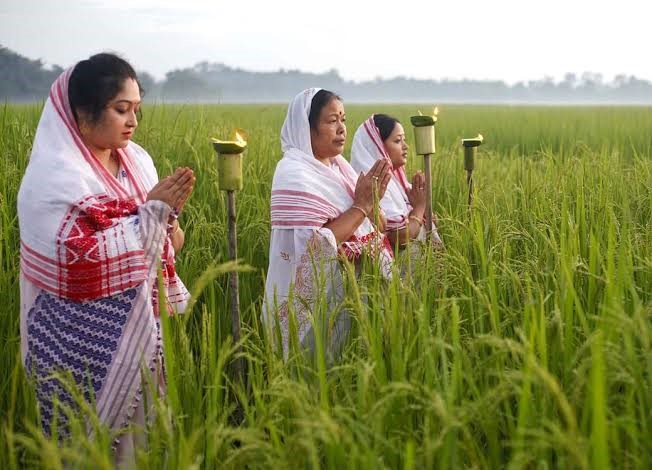
KATI BIHU

20.10.2023
KATI BIHU , Daily Current Affairs , RACE IAS : Best IAS Coaching in Lucknow
|
For Prelims: Kati Bihu,Bhogali Bihu,Rongali Bihu For mains GS paper 1: Significance,Rituals and Traditions,Assam(Drainage,Minerals) |
Why in the news?
The Prime Minister, Shri Narendra Modi extended best wishes on the auspicious occasion of KatiBihu to the people of Assam.
Kati Bihu
- This festival is one of the three Bihu festivals celebrated in the Indian state of Assam.
- Kati means to cut and this day marks the time of relocation of rice seedlings.
- It is also known as Kongali Bihu. (Kongali means poor).
- The Bihu festivals are an integral part of Assamese culture and are linked to the agricultural cycle.
- Kongali Bihu, also known as Kati Bihu, is the second Bihu festival and is celebrated in mid-October, marking the culmination of the sowing season and the beginning of the harvesting period.
Significance and Celebration
- This festival is primarily an agrarian festival that symbolizes the completion of the sowing of crops and the commencement of their growth.
- People light earthen lamps in front of the tulsi plant, the granary, and the paddy fields to seek blessings for a bountiful harvest.
- People wear traditional Assamese attire, and communities come together to participate in various cultural activities.
Rituals and Traditions
- They celebrate this festival by lighting the earthen lamps or candles and lighting their house with lighting.It symbolizes the worship of the goddess of wealth and the seeking of her blessings for a prosperous harvest.
- Lighting diya near Tulsi plant is one of the main parts of the festival. They worship Tulsi plant on this auspicious day.
- People also light a special lamp called "Akash Banti" (Sky candle) in their paddy fields.
- People offer prayers and offerings to various deities, seeking their blessings for the well-being of their families and the success of their agricultural endeavors.
- Kongali Bihu emphasizes community bonding, with people coming together to participate in cultural events, feasts, and various rituals, fostering unity and harmony within the community.
Traditional Cuisine
Pitha and Laru: Traditional Assamese sweets like pitha and laru (rice cakes) are prepared during Kongali Bihu. These delicacies are made with rice powder, jaggery, and coconut and are an essential part of the festive cuisine.
Bhogali Bihu (Magh Bihu):
- It is also called Bhogali Bihu, which is quintessentially the festival of food.
- The Magh Bihu marks the end of the harvesting season.
- The eve of the Magh Bihu is called the Uruka.
- It is the most gastronomical night of the year in Assam when family and friends get together and feasts around a bonfire.
- Bonfires are an essential part of Magh Bihu, where people gather around the fires, sing traditional songs, and engage in various cultural activities throughout the night.
Rongali Bihu (Bohag Bihu):
- It is also known as Bohag Bihu, is celebrated in mid-April, marking the beginning of the Assamese New Year and the arrival of the spring season. It is the most vibrant and widely celebrated of the Bihu festivals.
- The festival is marked by various cultural activities, including traditional Bihu dances, songs, and performances. People dress in traditional attire, and communities organize various cultural events, competitions, and fairs.
- It symbolizes the onset of the agricultural season, representing abundance, fertility, and the spirit of new beginnings.
Assam
- It is located in the tropical latitudes (24.3°N and 28°N) and eastern longitudes (89.5°E and 96.1°E).
- It is surrounded by 2 foreign countries, Bangladesh and Bhutan and 7 Indian states e.g. Arunachal Pradesh, Manipur, Nagaland, Meghalaya, Mizoram, Tripura and West Bengal.
- The major rivers Brahmaputra and Barak, in the North and South, form deep valleys.
- The Chicken neck corridor connects the North Indian plains and Brahmaputra plains, whose width is about 33 km on the eastern side and 22 km on the western side and the link is subjected to occasional disruptions due to heavy rain and flooding.
- It has three physiographic divisions:
(1) The Plateau Region or Karbi Plateau,
(2) The North Cachar Hills including the Barail Range,
(3) The alluvial plains of the (a) Brahmaputra Valley, (b)Barak Valley built up during the Sub-Recent and Recent periods.
Drainage:
- Assam falls under the regime of a typical monsoon climate.
- It receives an average annual rainfall of 100-300 cm.
- The state has numerous streams, rivers, and rivulets receiving water from the Himalayas and other surrounding hills and plateaus.
- The drainage of the state falls into two systems, namely, the Brahmaputra Basin and the Barak-Surma Basin.
- The watershed between the two basins run along with the highest southern ranges of Nagaland the Barail Range and the highest middle part of the Meghalaya plateau that runs east-west.
Minerals
- It is endowed with petroleum, natural gas, coal, limestone and many other minor minerals such as magnetic quartzite, kaolin, clay and feldspar.
- The Upper Assam districts are major reserves of oil and gas.It is the 3rd largest producer of petroleum (crude) and natural gas in the country accounting for 16% and 8% respectively of the total production of this mineral in the country.
- A Tertiary coal belt is located in Tinsukia, Dibrugarh, Sivasagar, Karbi Anglong and Dima Hasao districts with an estimated reserve of 370 million tonnes.
- It has rich limestone reserves. The major reserves of limestone are in Dima Hasao and Karbi Anglong districts. A total reserve of 97 million tonnes of limestone has been found in these two districts and almost half of the reserve is of cement grade.
Source:PIB